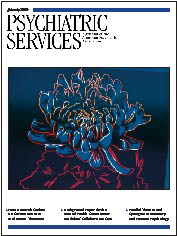Decreasing Unnecessary Care in a Psychiatric Emergency Service
Reducing the use of medically unnecessary emergency services is a way to reduce health care expenditures and provide better care for persons with true urgent and emergent needs. It has been estimated that 20 to 40 percent of emergency psychiatry visits are unnecessary. Despite efforts to redirect nonemergent psychiatric patients to more appropriate settings, many patients continue to rely on emergency services.
At the primary psychiatric emergency service in urban Detroit, staff developed an alternative, less costly, and more efficient service at the site of demand. Before this initiative, all presenting patients were provided with comprehensive services (assessment by a nurse, evaluation for substance abuse, psychosocial assessment, full assessment by a psychiatrist, laboratory work, and medication management). In our previous research, "needing medication" was one of four independent risk factors for high use of the psychiatric emergency service. The staff of the psychiatric emergency service developed a focused medication management level of care (brief assessment by a nurse and medication management by a psychiatrist) as an alternative to the more costly comprehensive care provided in the psychiatric emergency service.
The introduction of this alternative lower level of care raised concerns by community outpatient providers and the local community mental health payer. Community providers expressed fears that the psychiatric emergency service would "steal" their patients and substitute psychiatric emergency service care for more optimal outpatient care. The community mental health board was concerned that the psychiatric emergency service would not accurately identify patients who were in need of more comprehensive services. As a result, patients could deteriorate, they argued, resulting in increased inpatient admissions, more visits to the psychiatric emergency service, and "shopping" of other local psychiatric emergency departments for additional services. Although it has the potential to reduce costs in the targeted psychiatric emergency service, the new level of care was seen as having the potential to produce a net increase in costs to the system. The new level of care was formally implemented in late 2001 through mid-2002.
To evaluate the new level of care, we interviewed patients, surveyed psychiatric emergency service and community providers, and analyzed claims data from the local community mental health payer before and after introducing the focused medication reviews. Patients who received this level of care were overwhelmingly satisfied. Their mean score on a patient satisfaction questionnaire was 3.56 (with 4 representing "perfectly satisfied"). Ten percent of 84 patients reported that they had wanted hospitalization or shelter, but none were hospitalized in the following 30 days. There was no increased "shopping" for inpatient admission through emergency services at other facilities.
Psychiatric emergency service clinicians were also satisfied with the new level of care, reporting lighter workloads and perceived improvements in the quality of care. In contrast, community providers were less satisfied, perceiving their workload as increasing. The patients in this sample increased their rate of seeking care at outpatient clinics (from a median of .96 per year to 5.40 per year), with no significant increase in the rate of visits to the psychiatric emergency service. Thus the new level of care did not result in patients' being "stolen" from the outpatient clinics but, rather, encouraged more frequent outpatient care.
Furthermore, the number of patients who required hospitalization decreased from 22 to four among those who received the lower level of care. Thus it appears that the psychiatric emergency service can successfully identify patients in advance who do not need comprehensive psychiatric emergency service care. On the basis of claims data, we calculated a net median savings to the payer of at least $340 per patient per month for patients who were seen in the lower level of care.
In conclusion, we found that adding the option of a lower level of care in an urban psychiatric emergency service has potential to have a positive impact in multiple areas despite the less positive view held by some of the community providers. However, the program evaluation was limited to service use based on claims data and did not include direct assessment of symptoms and functioning at follow-up and did not control for temporal trends in health care use.
Despite the support for the focused medication review, it was discontinued in favor of less efficient comprehensive psychiatric emergency services to all patients, regardless of clinical justification. The fact that the medication review was discontinued underscores another issue in changing to a more efficient level of service—that of sustainability. Efforts by clinicians in the psychiatric emergency service to create new billing codes reflecting the lower levels of care were unsuccessful. Furthermore, other local third-party payers rejected claims for the new level of care on the basis that medication reviews can be provided in an outpatient setting even though patients present at the psychiatric emergency service instead.
Our experience highlights the fact that improved efficiency, improved patient and provider satisfaction, and higher perceived quality of care are not enough to result in sustainability of new initiatives. Multiple system factors need to be accounted for when attempting to alter long-standing protocols, involving multiple stakeholders with sometimes competing agendas.
The authors are affiliated with the department of psychiatry and behavioral sciences of Wayne State University in Detroit, Michigan. Send correspondence to Dr. Arfken at 2761 East Jefferson Avenue, Detroit, Michigan 48207 (e-mail, [email protected]).



